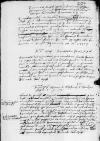List #1771
Ioannes DANTISCUS do Fernando de GUEVARALöbau (Lubawa), 1537-11-16
Rękopiśmienne podstawy źródłowe:
Pomocnicze podstawy źródłowe:
Publikacje:
| ||||||||||
Tekst + aparat krytyczny + komentarzZwykły tekstTekst + komentarzTekst + aparat krytyczny
Ioannes etc., Dei gratia episcopus Culmensis, administrator Pomesaniensis et ad episcopatum Varmiensem postulatus, Egregio Domino doctori Gueuarre salutem plurimam dicit.
Quod nobis eruditum
Ex

 BCz, 244, p. 293
BCz, 244, p. 293